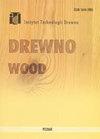Carbon monoxide and nitric oxide concentrations in the flue gas during the combustion of agricultural biomass briquettes in a 25 kW log gasification boiler
IF 0.9
4区 农林科学
Q3 MATERIALS SCIENCE, PAPER & WOOD
引用次数: 0
Abstract
A study was made of the two-stage combustion of agricultural biomass briquettes (rye straw, miscanthus, hay, corn stover) in a 25 kW wood log gasification boiler. The following correlations for selected fuel loads and biomass types were shown: fluctuation of temperature over time both in the gasification chamber and in the combustion zone, variation over time of carbon monoxide and nitric oxide concentrations, correlation between nitric oxide and carbon monoxide concentrations in the flue gas, and variation of carbon monoxide and nitric oxide concentrations versus oxygen concentration and temperature in the combustion zone. Two-stage combustion of agricultural biomass proved to be efficient, as slag was not generated. Relatively high carbon monoxide concentrations in the flue gas resulted from the lack of automated regulation of air supply to the gasification chamber and the combustion zone.25kw原木气化锅炉中农业生物质型煤燃烧过程中烟气中的一氧化碳和一氧化氮浓度
研究了农业生物质型煤(黑麦秸秆、芒草、干草、玉米秸秆)在25kw原木气化锅炉上的两段燃烧。所选燃料负荷和生物质类型的以下相关性显示:气化室和燃烧区温度随时间的波动,一氧化碳和一氧化氮浓度随时间的变化,烟气中一氧化氮和一氧化碳浓度之间的相关性,以及一氧化碳和一氧化氮浓度随燃烧区氧气浓度和温度的变化。农业生物质的两段燃烧被证明是有效的,因为不产生渣。烟气中相对较高的一氧化碳浓度是由于气化室和燃烧区的空气供应缺乏自动调节造成的。
本文章由计算机程序翻译,如有差异,请以英文原文为准。
求助全文
约1分钟内获得全文
求助全文
来源期刊

Drewno
MATERIALS SCIENCE, PAPER & WOOD-
CiteScore
1.10
自引率
12.50%
发文量
0
审稿时长
>12 weeks
期刊介绍:
Wood. Research papers. Reports. Announcements" ("Drewno") is an international scientific journal that publishes original results of innovatory basic and applied research concerning technological, technical, economic and ecological issues important for the wood science and forest-based industries, including their environment, and interesting to the international recipients. "Drewno" is an Open Access biannual journal.
Aims and scope:
wood science: anatomy, biology, chemistry, physics
wood mechanical and chemical technology, inter alia, sawmilling, composite wood products, wooden construction, furniture making, wood pulp, paper making
material engineering, biocomposites, nanocomposites
material management
environmental protection, safety of the processes, products and working stations
biotechnology
bioenergy, biofuels
forestry: harvesting and wood quality
wood-based industries economics
The Editorial Board of the journal especially welcomes articles concerning increase in wood resources (wood mobilisation); innovative composites and lignocellulosic materials; new trends in the protection, modification and finishing of wood; biorefining of raw wood material; "green" building; new technologies of wood waste recycling; sustainable development; innovation management; and business networks.
 求助内容:
求助内容: 应助结果提醒方式:
应助结果提醒方式:


